|
|
"Where are we?"
Well, yes. We're sitting here safe and dry in the Science
Museum at the University of Coimbra. But the question has
a different urgency when the ship is approaching a rocky
coast and the life of the ship and its crew depends on a
fast and accurate answer. It's the Navigator's job to
provide the answer.
So what do navigators need to find their position on
the earth's surface by observing the stars?
- They need an Almanac
prepared by the astronomers to forecast precisely
where the heavenly bodies, the sun, moon planets
and selected navigational stars, are going to be,
hour by hour, years into the future, relative to
the observatory that prepared the almanac,
Greenwich, England in modern times.
- They need a chronometer or
some other means of telling the time back at the
observatory that was the reference point for the
data in the almanac,
- It is the cartographer's
job to provide accurate charts so that navigators
can establish their position in latitude and
longitude or in reference to landmasses or the
hazards of rocks and shoals.
- The navigators need a quick
and easy mathematical method for reducing the
data from their celestial observations to a
position on the chart
- Finally, navigators need an
angle-measuring instrument, a sextant, to measure
the angle of the celestial body above a
horizontal line of reference.
How do navigators use the stars, including our
sun, the moon, and planets to find their way? Well, for
at least two millennia, navigators have known how to
determine their latitude — their position north or
south of the equator. At the North Pole, which is 90
degrees latitude, Polaris (the North Star) is directly
overhead at an altitude of 90 degrees. At the equator,
which is zero degrees latitude, Polaris is on the horizon
with zero degrees altitude. Between the equator and the
North Pole, the angle of Polaris above the horizon is a
direct measure of terrestrial latitude. If we were to go
outside tonight and look in the northern sky, we would
find Polaris at about 40 degrees 13 minutes altitude -
the latitude of Coimbra.
In ancient times, the navigator who was planning to
sail out of sight of land would simply measure the
altitude of Polaris as he left homeport, in today’s
terms measuring the latitude of home port. To return
after a long voyage, he needed only to sail north or
south, as appropriate, to bring Polaris to the altitude
of home port, then turn left or right as as appropriate
and "sail down the latitude," keeping Polaris
at a constant angle.
The Arabs knew all about this technique. In early
days, they used one or two fingers width, a thumb and
little finger on an outstretched arm or an arrow held at
arms length to sight the horizon at the lower end and
Polaris at the upper.
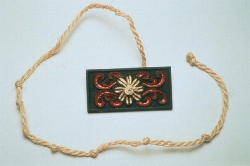 |
Kamal |
In later years, they used a simple device called a
kamal to make the observation. The kamal shown
here actually is a modern piece that I made, but
it’s very much like the ones used a thousand years
ago, and probably much earlier. Notice the knots in the
cord attached to the carved mahogany transom. Before
leaving homeport, the navigator would tie a knot in the
cord so that, by holding it in his teeth, he could sight
Polaris along the top of the transom and the horizon
along the bottom.
To return to homeport, he would sail north or south as
needed to bring Polaris to the altitude he’d
observed when he left home, then sail down the latitude.
Over time, Arab navigators started tying knots in the
string at intervals of one issabah. The word issabah
is Arabic for finger, and it denotes one degree 36
minutes, which was considered to be the width of a
finger. They even developed a journal of different ports
that recorded which knot on the kamal corresponded
to the altitude of Polaris for each port they frequently
visited.
Throughout antiquity, the Greeks and Arabs steadily
advanced the science of astronomy and the art of
astrology. About a thousand years ago, in the 10th
century, Arabs introduced Europe to two important
astronomical instruments—the quadrant and the
astrolabe.
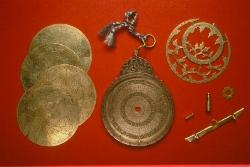 |
Astronomers
Astrolabe. Arabic astronomer's astrolabe
made by Hajji Ali of Kerbala around 1790.
It’s about 3 and one-half inches in
diameter. It was used to find the time of rising
and setting of the sun and the altitude of the
sun and selected stars. Importantly, it was used
to find the direction of Mecca for the devout
Moslem's morning and evening prayers. |
In the word "astrolabe" - "astro
means ‘star’ and "labe"
roughly translates as ‘to take’ or 'to find.'
The astronomer's beautiful, intricate and expensive
astrolabe was the grandfather of the much simpler, easy
to use mariner's quadrant and astrolabe. The
mariner’s quadrant—a quarter of a circle made
of wood or brass--came into widespread use for navigation
around 1450, though its use can be traced back at least
to the 1200s.
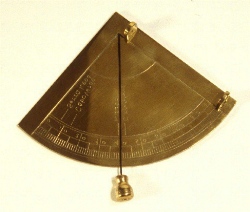 |
Mariner’s
brass quadrant. The scale spans 90 degrees
and is divided into whole degrees. A plumb bob
establishes a vertical line of reference. The
quadrant shown here is a replica of the type
Columbus might have used on his voyages to the
New World. This one
is marked off at the latitudes of Lisbon, Cabo
Verde and Serra Leoa, down near the Equator where
Columbus is known to have visited. |
The quadrant was a popular instrument with Portuguese
explorers. Columbus would have marked the observed
altitude of Polaris on his quadrant at selected ports of
call just as the Arab seaman would tie a knot in the
string of his kamal.
Alternatively, the navigator could record the altura,
or altitude, of Polaris quantitatively in degrees at
Lisbon and at other ports to which he might wish to
return. It wasn’t long before lists of the alturas
of many ports were published to guide the seafarer up and
down the coasts of Europe and Africa.
During the 1400’s, Portuguese explorers were
traveling south along the coast of Africa searching for a
route to the orient. As a seafarer nears the equator
heading south, Polaris disappears below the horizon. So,
in southern seas, mariners had to have a different way of
finding their latitude. Under orders from the Portuguese
Prince Henry, The Navigator, by 1480, Portuguese
astronomers had figured out how to determine latitude
using the position of the sun as it moved north and south
of the equator with the seasons, what we now call its
"declination." In simple terms, the navigator
could determine his altura, his latitude, by using
his quadrant to take the altitude of the sun as it came
to it’s greatest altitude at local apparent noon,
and then making a simple correction for the position of
the sun north or south of the equator according to the
date.
The mariner’s quadrant was a major conceptual
step forward in seagoing celestial navigation. Like the
knots-in-a string method of the Arab kamal, the
quadrant provided a quantitative measure, in degrees, of
the altitude of Polaris or the sun, and related this
number to a geographic position—the latitude--on the
earth’s surface. But for all its utility, the
quadrant had two major limitations: On a windy, rolling
deck, it was hard to keep it exactly vertical in the
plane of a heavenly body. And it was simply impossible to
keep the wind from blowing the plumb bob off line.
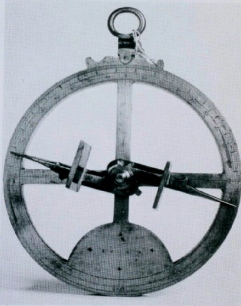 |
A
beautiful mariners’ astrolabe made in Lisbon
by J. de Goes in 1608, now in
the Museum of the History of Science, Florence,
Italy |
Mariner's astrolabes are now very rare and expensive -
less than one hundred are known to survive and most of
these are in poor condition having been recovered from
ship wrecks.
The seagoing astrolabe was a simplified version of the
much more sophisticated Middle Eastern astronomer’s
astrolabe that we saw a moment ago. All the complex
scales were eliminated, leaving only a simple circular
scale marked off in degrees. A rotatable alidade
carried sighting pinnules. Holding the instrument at eye
level, the user could sight the star through the pinnules
and read the star’s altitude from the point where
the alidade crosses the scale.
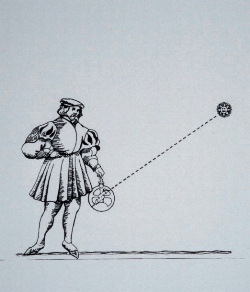 |
Astrolabe
in use.For a sun sight, the astrolabe was
allowed to hang freely and the alidade was
adjusted so that a ray of sunlight passed through
the hole in the upper vane and fell precisely on
the hole in the lower vane. |
The astrolabe was popular for more than 200 years
because it was reliable and easy to use under the
frequently adverse conditions aboard ship.
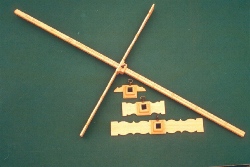 |
A
cross-staff. This
one is a modern reproduction in the style popular
with Dutch navigators in the eighteenth century. |
The next step in the evolution of celestial navigation
instruments was the cross-staff, a device resembling a
Christian cross. Interestingly, its operating principle
was the same as that of the kamal. The vertical
piece, the transom or limb, slides along the staff so
that the star can be sighted over the upper edge of the
transom while the horizon is aligned with the bottom
edge.
The Persian mathematician Avicenna wrote about a
cross-staff in the eleventh century. The concept probably
arrived in Europe when Levi ben Gerson, working in the
Spanish school at Catalan in 1342, wrote about an
instrument called a balestilla that he described
as a being made from a "square stick" with a
sliding transom.
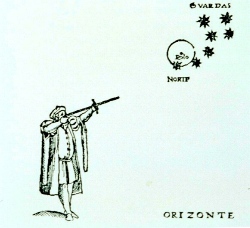 |
A
cross-staff in use. This drawing, from a
Spanish book on navigation published in 1552,
shows how the cross-staff was used to determine
the altitude of Polaris. If you’ve ever
heard the phrase "shooting the stars,"
it comes from the practice of holding a
cross-staff up to the user’s eye with one
hand, with the transom grasped in the other hand
so that the person looks like an archer taking
aim at the sun. |
Early cross-staffs had only two pieces - the staff and
one transom. Over time they became more elaborate. After
1650, most "modern" cross-staffs have four
transoms of varying lengths. Each transom corresponds to
the scale on one of the four sides of the staff. These
scales mark off 90, 60, 30, and 10 degrees, respectively.
In practice, the navigator used only one transom at a
time.
The major problem with the cross-staff was that the
observer had to look in two directions at once - along
the bottom of the transom to the horizon and along the
top of the transom to the sun or the star. A neat trick
on a rolling deck!
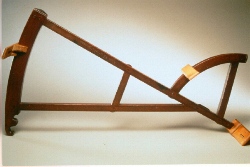 |
Davis
quadrant. Made by an English craftsman named
Walter Henshaw in 1711. It’s made of
rosewood with a diagonal scale on boxwood. |
One of the most popular instruments of the seventeenth
century was the Davis quadrant or back-staff.
Captain John Davis conceived this instrument during his
voyage to search for the Northwest Passage. It was
described in his Seaman’s Secrets published
in 1595. It was called a quadrant because it could
measure up to 90 degrees, that is, a quarter of a circle.
The observer determined the altitude of the sun by
observing its shadow while simultaneously sighting the
horizon. Relatively inexpensive and sturdy, with a proven
track record, Davis quadrants remained popular for more
than 150 years, even after much more sophisticated
instruments using double-reflection optics were invented.
One of the major advantages of the Davis back-staff
over the cross-staff was that the navigator had to look
in only one direction to take the sight - through the
slit in the horizon vane to the horizon while
simultaneously aligning the shadow of the shadow vane
with the slit in the horizon vane.
The major problem
with back-sight instruments was that it was difficult if
not impossible to sight the moon, the planets or the
stars. Thus, toward the end of the 1600's and into the
1700's, the more inventive instrument makers were
shifting their focus to optical systems based on mirrors
and prisms that could be used to observe the nighttime
celestial bodies.
The critical development was made independently and
almost simultaneously by John Hadley in England and by
Thomas Godfrey, a Philadelphia glazier, about 1731. The
fundamental idea is to use of two mirrors to make a
doubly reflecting instrument—the forerunner of the
modern sextant.
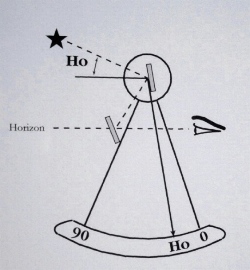 |
Diagram
of sextant |
How does such an instrument work? How many of you have
ever held a sextant in your hand? Hold the instrument
vertically and point it toward the celestial body. Sight
the horizon through an unsilvered portion of the horizon
mirror. Adjust the index arm until the image of the sun
or star, which has been reflected first by the index
mirror and second by the silvered portion of the horizon
mirror, appears to rest on the horizon. The altitude of
the heavenly body can be read from the scale on the arc
of the instrument’s frame.
Hadley's first doubly reflecting octants were made
from solid sheets of brass. They were heavy and had a lot
of wind resistance. Lighter wooden instruments that could
be made larger, with scales easier to divide accurately
and with less wind resistance quickly replaced them.
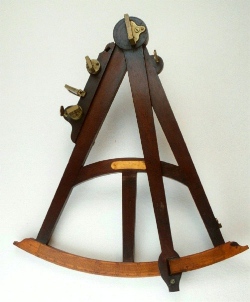 |
Early
Hadley octant. This mahogany octant was made
about 1760 by the famous London maker, George
Adams. |
Hadley' octant of 1731 was a major advancement over
all previous designs and is still the basic design of the
modern sextant. It was truly a "point and
shoot" device. The observer looked at one place -
the straight line of the horizon sighted through the
horizon glass alongside the reflected image of the star.
The sight was easy to align because the horizon and the
star seemed to move together as the ship pitched and
rolled.
We have seen how navigators could find their latitude
for many centuries but ships, crews and valuable cargo
were lost in shipwrecks because it was impossible to
determine longitude. Throughout the seventeenth century
and well into the eighteenth century, there was an
ongoing press to develop techniques for determining longitude. The missing
element was a way to measure time accurately. The clock
makers were busy inventing ingenious mechanical devices
while the astronomers were promoting a celestial method
called "lunar distances". Think of the moon as
the hand of a clock moving across a clock face
represented by the other celestial bodies. Early in the
18th century, the astronomers had developed a
method for predicting the angular distance between the
moon and the sun, the planets or selected stars. Using
this technique, the navigator at sea could measure the
angle between the moon and a celestial body, calculate
the time at which the moon and the celestial body would
be precisely at that angular distance and then compare
the ship’s chronometer to the time back at the
national observatory. Knowing the correct time, the
navigator could now determine longitude. When the sun
passes through the meridian here at Coimbra, the local
solar time is 1200 noon and at that instant it is 1233 PM
Greenwich Mean Time. Remembering that 15 degrees of
longitude is equivalent to one hour of time gives us the
longitude of 8 degrees, 15 minutes West of Greenwich. The
lunar distance method of telling time was still being
used into the early 1900’s when it was replaced by
time by radio telegraph.
An octant measures angles up to 90 degrees and is
ideally suited for observations of celestial bodies above
the horizon. But greater angle range is needed for lunar
distance observations. It was a simple matter to enlarge
Hadley's octant, an eighth of a circle, to the sextant, a
sixth of a circle, that could measure up to 120 degrees.
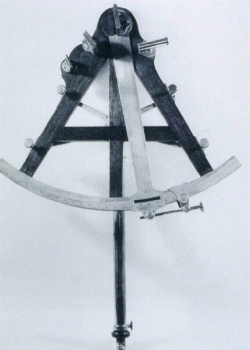 |
An
early sextant by John Bird. The first sextant
was produced by John Bird in 1759. This is a very
early example of his work now in the Nederlands
Scheepvaart Museum in Amsterdam. The frame is
mahogany with an ivory scale. It is so large and
heavy that it needed a support that fitted into a
socket on the observers belt. |
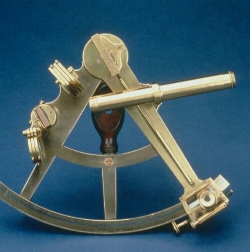 |
A
brass sextant by Dollond. Here’s a fine
brass sextant from the early nineteenth century
by the master London instrument maker John
Dollond. |
In the first half of the
eighteenth century there was a trend back to wooden frame
octants and sextants to produce lighter instruments
compared to those made of brass.
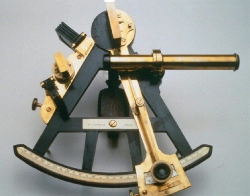 |
Ebony
sextant. A very handsome example by H.
Limbach of Hull of a sextant with an ebony frame.
Ebony was used because of the dense wood's
resistance to humidity. The scale and vernier
were divided on ivory, or should we now say bone.
The design was not successful because the wood
tended to split over the long arc of a sextant. |
-
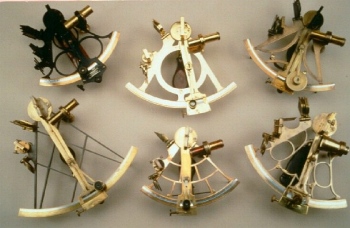 |
Examples
of sextant frame designs. A sample of
variations in frame design. The challenge was to
produce sextant frames that were light weight,
low wind resistance and with a minimum change is
dimensions with changes in temperature. As you
can see, some of them are quite esthetically
pleasing.
|
-
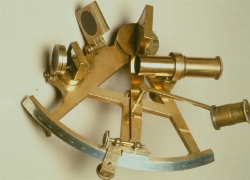 |
Ramsden
pentant. To be correct, the instrument
should be called a pentant, a fifth of a circle,
rather than a sextant. This jewel is only 4 1/2
inches radius. The scale is divided on silver
from minus 5 degrees to 155 degrees with each
degree further divided in three to 20 arc
minutes. As you can see, the scale is beveled at
45 degrees. Why set the scale at an angle to the
frame - perhaps just to show that he could do it! |
Probably the finest 18th century instrument
maker was the Englishman Jesse Ramsden. His specialty was
accurate scale division. Here’s
a small brass sextant that Ramsden made shortly before
his death in 1800. Ramsden's major achievement was to
invent a highly accurate "dividing
engine"—the apparatus used to divide the scale
into degrees and fractions of degrees. His design was
considered so ingenious that the British Board of
Longitude awarded Ramsden a prize of 615 pounds—in
18th century terms, a small fortune. His
"dividing engine" now resides in the
Smithsonian Institution in Washington.
The development of more precise scale division was a
milestone in instrument development. Certainly, it
permitted more accurate observations but it also
permitted smaller, lighter, more easily handled
instruments. The sextant you see here is my all-time
favorite.
|